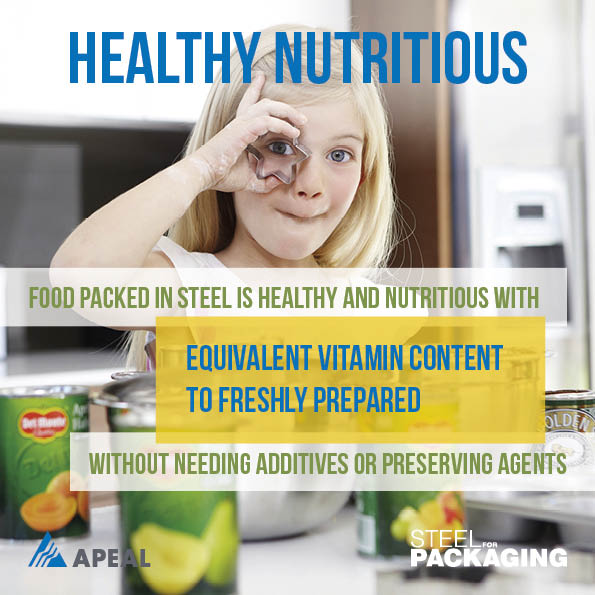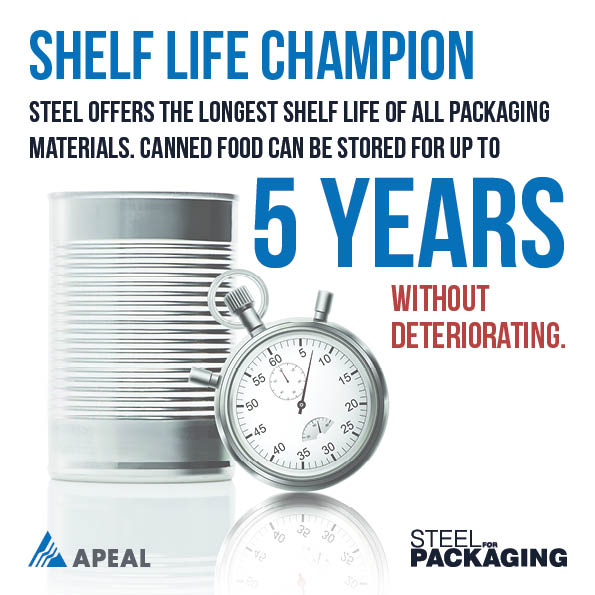Food has highest nutritional value when it is harvested. Fresh produce starts degrading as soon as it’s picked from the ground or tree, because that ground or tree is its source of nutrients and energy.
According to Elisabeth Payeux of the French Canning Institute CTCPA, vitamins are preserved at the rate of about 70% in canned products, similar to the content in fresh foods that have been stored for several days before eating.
Since canning technology came of age in the 20th century, the can has been a safe, effective and affordable means of not only preserving food, but locking in nutrients, such as vitamins and fatty acids, in both premium products and everyday items.
| In addition, modern farming, harvesting and packing practices mean that fruit and vegetables are canned quickly after harvesting, usually within as little as four hours. |
Canning works by heating airtight cans to sterilise the food inside them, as sterilisation by heat retains the macronutrients, proteins, lipids and carbohydrates of food.
Such quick processing facilitates the preservation of most of the original organoleptic and nutritional qualities of the produce and limits the loss of water-soluble vitamins (C and Group B vitamins).
Indeed, research carried out by the German SGS Fresenius Institute in 2015[1] showed that the vitamin content of food packaged in steel is equal to and sometimes even higher than that of freshly prepared without needing additives or preserving agents. 200g canned tomatoes were shown to contain one third of the recommended daily intake of vitamin C and two thirds of the recommended daily intake of vitamin A, well ahead of the freshly prepared equivalent.
Similarly, many types of fish such as salmon, tuna and sardines are canned shortly after being caught, preserving beneficial nutrients such as Omega 3 fatty acids.
The advantages of safely packaging and protecting food truly comes into focus when we consider the significant global challenges that remain in the fight against food insecurity and malnutrition.
 According to Unicef, close to 750 million – or nearly one in ten people in the world – were exposed to severe levels of food insecurity in 2019 and the figures show an upward trend[2]. Put simply, if recent trends continue, the UN objective of Zero hunger by 2030[3] will not be reached. Despite this, an estimated 88 million tonnes of food is wasted every year in the EU[4].
According to Unicef, close to 750 million – or nearly one in ten people in the world – were exposed to severe levels of food insecurity in 2019 and the figures show an upward trend[2]. Put simply, if recent trends continue, the UN objective of Zero hunger by 2030[3] will not be reached. Despite this, an estimated 88 million tonnes of food is wasted every year in the EU[4].
Using steel for packaging can be part of the solution, as food packed in steel stays fresh for longer, retains its flavour and is less likely to be damaged, spoiled, or unnecessarily wasted.
Steel’s strength and 100% barrier against light, water and air protects food, minimising product loss during transport and storage. Misshapen or “ugly” food which might be rejected as fresh by stores can be canned and processed as normal, minimising unnecessary product loss to landfill.
Portion sized packaging allows consumers to buy in precise quantities, minimising the amount of food that is thrown away by householders. And finally, steel packaging allows consumers to store and access food for long periods without the need for energy-consuming fridges or freezers.
 Totally lightproof and oxygen tight, with shelf life up to 3 years (5 years for some canned food products), longer than any other packaging for equivalent goods (glass up to 2 years, pouch 18 months, carton 12 months, rigid plastics 4 weeks)
Totally lightproof and oxygen tight, with shelf life up to 3 years (5 years for some canned food products), longer than any other packaging for equivalent goods (glass up to 2 years, pouch 18 months, carton 12 months, rigid plastics 4 weeks)
Often the newest materials are seen as the best, the most innovative, and therefore the most efficient. However, when considering food packaging, we must not overlook a solution that has been effectively and efficiently preserving food for two centuries, without contributing to an increase in packaging waste.
As we navigate our way towards a more sustainable future, steel provides a multiple and fully recyclable solution to help us meet the world’s nutritional and environmental needs.
To find out more read Living and eating well with canned products, by Elisabeth Payeux, Deputy Managing Director CTCPA, French Technical centre for the food canning industry
[1] Initiative-lebensmitteldose.de
[2] The state of food security and nutrition in the world 2020 | UNICEF
